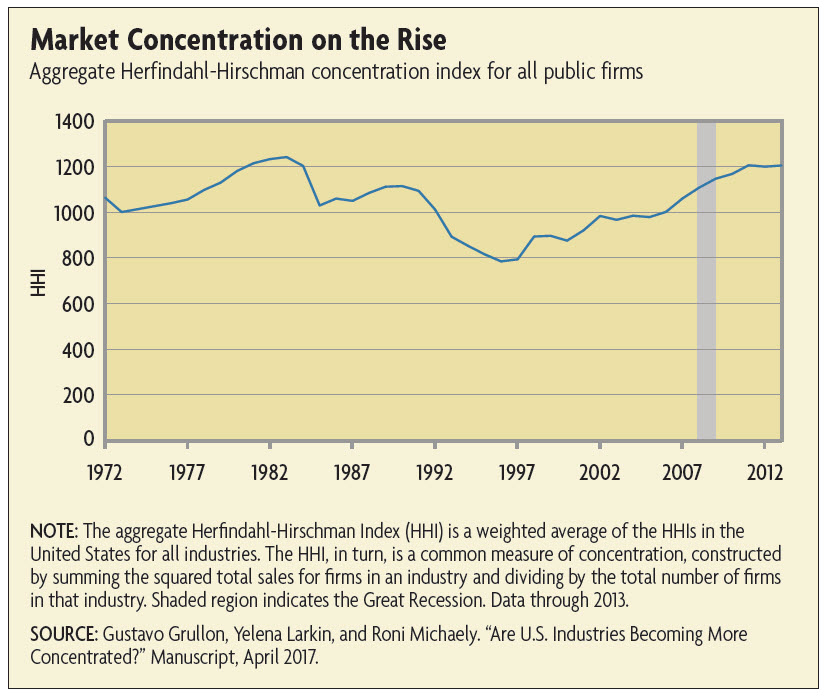We discuss mergers and when the government (Justice Department or Federal Trade Commission) might challenge mergers.
If two firms merge, the new firm, of course, has a bigger share of the market than either of the old firms. When does this gain in market share threaten competition enough to be challenged in court?
Waldoch mentions the Herfindahl–Hirschman Index HHI. The market share of each firm in an industry is squared and then all those numbers are added up to get the HHI. There are 3 categories according to Justice:
Unconcentrated Markets: HHI below 1500
Moderately Concentrated Markets: HHI between 1500 and 2500
Highly Concentrated Markets: HHI above 2500
One thing to add is that if a merger increases the HHI by more than 100 points and the new HHI of the industry is Moderately Concentrated, then the merger is likely to be challenged.
Excerpt from Taylor's post:
"For example, here's a figure from an article by Tim Sablik, "Are Markets Too Concentrated?" published in Econ Focus, from the Federal Reserve Bank of Richmond (First Quarter 2018, pp. 10-13). The HHI is a standard measure of market concentration: it is calculated by taking the market share of each firm in an industry, squaring it, and then summing the result. Thus, a monopoly with 100% of the market would have a HHI measure of 1002 , or 1,000. A industry with, say, two leading firms that each have 30% of the market and four other firms with 10% of the market would have an HHI of 2200. The average HHI across industries has indeed risen--back to the level that prevailed in the late 1970s and early 1980s.Related posts:
A couple of other points are worth noting:
In some of the industries where concentration has risen, recent legislation is clearly one of the important underlying causes. For example, healthcare providers and insurance firms became more concentrated in the aftermath of restrictions and rules imposed by the Patient Protection and Affordable Care act of 2010. The US banking sector became more concentrated in the aftermath of Wall Street Reform and Consumer Protection Act of 2010 (the Dodd-Frank act). In both cases, supporters of the bill saw additional concentration as a useful tool for seeking to achieve the purported benefits of the legislation.
The rise in bigness that seems to bother people the most is the dominance of Apple, Alphabet, Amazon, Facebook, and Microsoft. The possibility that these firms raise anticompetitive issues seems to me like a very legitimate concern. But it also suggests that the competition issues of most concern apply mostly to a relatively small number of firms in a relatively small number of tech-related industries."
Herfindahl-Hirschman at the Movies
The Herfindahl-Hirschman Index & The Anheuser-Busch InBev/Grupo Modelo Merger
Is The Airline Industry An Oligopoly?


No comments:
Post a Comment